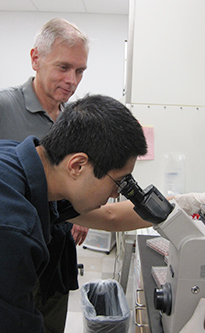 Diane Aum
Diane Aum
Glioblastoma multiforme (GBM) is one of the most malignant and aggressive brain tumors with a short survival time and limited treatment options. Currently, glioblastoma multiforme is poorly understood at a molecular level. Nicotinamide adenine dinucleotide (NAD) is a compound involved in cell metabolism which likely plays important roles in the development and progression of GBM. Studying the role of NAD in GBM could elucidate important mechanisms in its pathogenesis which could lead to new approaches for treatment of this challenging disease. Nicotinamide phosphoribosyltransferase (NAMPT) catalyzes the rate-limiting step in NAD recycling, which plays an important role in the metabolic activity critical for cancer cell function. Increased NAMPT expression has been found in mRNA in human glioblastoma tumors and tumor-initiating cell (TIC) cultures (TCGA and unpublished data, Kim lab). The hypothesis of this study is that the inhibition of NAMPT decreases cellular NAD levels and leads to a decrease in the self-renewal, invasiveness, and tumorigenesis of cancer stem cells in Glioblastoma multiforme (GBM). The project aims are to observe and measure the effect of decreased NAD levels on the self-renewal, invasiveness, and tumorigenesis of human glioblastoma TICs. Given that NAD-dependent processes mediate critical cellular events and that NAMPT mRNA is elevated in glioblastoma and glioblastoma TICs, reducing NAD levels by NAMPT inhibition should result in decreased self-renewal, invasiveness, and tumorigenesis of GBM TICs.
 James Zou
James Zou
The purpose of my project was to generate monoclonal antibodies, which collectively recognize a single epitope, against three human proteins: Pyhin1, a member of the HIN-200 interferon-inducible proteins that acts as a tumor suppressor; Reg3G, an anti-bacterial protein that targets Gram-positive bacteria; and IL-26, a cytokine that is recognized by epithelial cells and helps promote antimicrobial functions and cell survival. All three of these proteins are involved in mucosal immunity, which is mediated by the division of the immune system that protects the mucous membranes. Mucous membranes are found throughout the body, such as in the mouth and lining the gut and bladder. These antibodies can be used for immunohistochemistry on human tissue samples to visualize the localization and production of these molecules during infections of the mucosa relative to the resting state. This is important because the human mucosal immune system is poorly understand, and tools allowing for its analysis are scarce. These antibodies may also serve as therapeutic agents, for instance by diminishing inflammation associated with Pyhin1 activity or sequestering IL-26, which presumably could, through its ability to promote cell survival, play a role in the formation of certain types of cancer if inappropriately regulated or produced.
